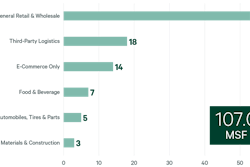
Supply chain disruption is now the market standard, not the exception. As we head into another uncertain year, failing to see disruptions coming is no longer an excuse. The only thing that is truly predictable about this year is that it will be unpredictable.
Staying ahead of supply chain disruptions in 2023 requires a clear picture of all risks and the ability to act swiftly. While the year promises to bring many unknowns, here are 3 big developments to keep your eye on:
1.) Re-sourcing from China becomes impossible for large enterprises
This year, expect to see many of the companies that initially boasted plans to nearshore go back on their promises and face more risk because of it.
The current geopolitical climate has shone a bright light on the risk of doing business in Russia, China and dozens of other countries. Pulling out sounds like the right move, but it takes years to build and optimize a new supply chain without negatively impacting product availability or quality. Given the current level of overreliance the notion of pulling out of China in 2023 is impossible.
Supply chain leaders will focus on a more practical goal. Building a long-term plan for scaling back from high-risk areas while changing how they prioritize and attack location and geopolitical risks. For years, location and geopolitical issues took a back seat to more traditional supply chain risks, like cyber and financial.
That period is long over. After Russia invaded Ukraine, countries and companies around the globe pulled operations from Russia with several experiencing heavy losses. Location and geo-political risk matter more than ever and companies need a strategy in place to see them coming and act before disaster hits.
2.) Extreme political candidates increase economic uncertainty
Extreme candidates from all political sides are getting elected globally. The result is the global economy continues to move further away from worldwide convergence of opinion and more toward polarization. We’re seeing less collaboration with UN policies and global alliances and more separation and disagreement, which ultimately fuels economic uncertainty and risks.
By extending China’s president, Xi Jinping’s authoritarian rule for another 5 year term over the world’s second-largest economy and continuing to tighten the Chinese Communist Party’s grip on the state and society, the geopolitical risk between China and the rest of the globe heightens. How will this impact relations with the West, and could tensions boil over into economic and supply disruption? To the latter question the answer is near 100% yes.
If the division between prominent countries grows, said extreme political leaders will likely make decisions for themselves rather than those that positively impact their allies or the global economy. Looking at 2023, all the risk indicators of potential geopolitical disruption exist. The question is do companies see the signs, and are they equipped to proactively act and avoid a substantial negative event where companies are forced to abandon Russian operations with little notice or planning?
3.) Business swap annual scenario planning for real-time risk monitoring
We saw the repercussions of once-a-year scenario planning these past few years as sudden world events caused catastrophic business disruptions in the blink of an eye, from war to natural disasters and everything in between. Even quarterly and monthly updates left businesses blind to the risk events that spread like wildfire, yet leaders ignored the need for real-time data and action.
Extreme marketplace volatility puts immense pressure on supply chains and can disrupt normal operations on a dime. This new reality makes annual scenario planning nearly useless and presents an urgent opportunity to reevaluate and change risk monitoring practices.
This year, expect to see a major shift in the mindset on how boards and the C-suite approach risk monitoring and management. Leaders will prioritize real-time data for proactive risk mitigation instead of relying on stale point-in-time assessments and invest in more technology, insights and automation to defend their businesses. One of the subtle but important changes will be prioritizing risk monitoring data that not only shows what’s happening but can connect to and trigger actions and automated workflows that counter said risks.
Bracing for another year of chaos
While there is always uncertainty heading into the new year, the past few years have taught us a lot about the necessary best practices and steps companies need to take to be resilient.
The biggest lesson is that disruption is the norm not an anomaly. We can’t predict what will happen, but we can prepare and that starts with a more modern, continuous and intelligent risk management strategy.



















